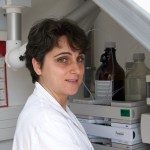Link to Pubmed [PMID] – 11221889
Cancer Res. 2001 Feb;61(3):950-6
A synthetic peptide corresponding to the human MUC2 tandem repeat unit was glycosylated in vitro using UDP-GalNAc and extracts of colonic adenocarcinoma and paired normal mucosa, followed by fractionation of the products by reverse phase high-performance liquid chromatography. Several peaks of glycopeptides with different numbers of GalNAc residues attached were detected. It is notable that the adenocarcinoma extract was capable of glycosylating peptides to a much greater extent than was normal mucosa. The levels of mRNA for N-acetylgalactosaminyltransferases-1, -2, and -3 were determined by reverse transcription-PCR. Only N-acetylgalactosaminyltransferase-3 mRNA was expressed at a higher level in the adenocarcinoma than in the normal tissue. When the MUC2 tandem repeat peptide was glycosylated with a mixture of the normal mucosa extract and recombinant N-acetylgalactosaminyltransferase-3, larger amounts of glycopeptides with higher contents of GalNAc residues were produced. The MUC2 tandem repeat peptides glycosylated extensively by recombinant N-acetylgalactosaminyltransferase-1, -2, or -3 were prepared and characterized. Substitution at each Thr residue, as revealed by Edman degradation sequencing, in conjunction with evidence obtained on mass spectrometry indicated a heterogeneous pattern of site-specific glycosylation within the MUC2 tandem repeat. It was found that maximum numbers of 6, 8, and 11 GalNAc residues were incorporated by N-acetylgalactosaminyltransferases-1, -2, and -3, respectively, and that only N-acetylgalactosaminyltransferase-3 could completely glycosylate both consecutive sequences composed of three and five Thr residues in the MUC2 tandem repeat unit. These results suggest that O-glycosylation of the clustered Thr residues is a selective process controlled by N-acetylgalactosaminyltransferase-3 in the synthesis of clustered carbohydrate antigens.

